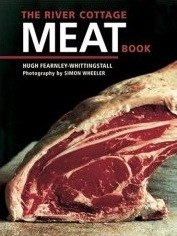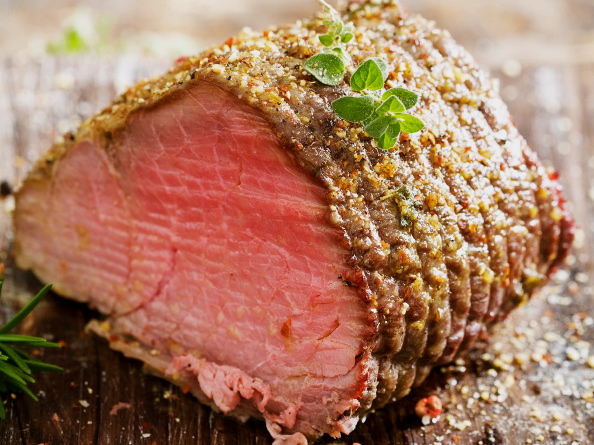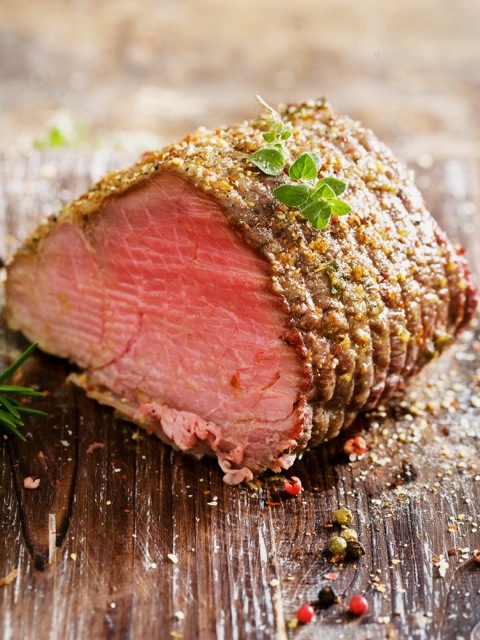
reference-image, l
(article, Emily Stone)
[%pageBreakSettings nobreak=true] [%adInjectionSettings noInject=true] I started reading Hugh Fearnley-Whittingstall’s meat book in bed. Sounds juicy, no? But since The River Cottage Meat Book is 544 pages, hardbound, the proposition was actually rather awkward; I had to balance the book on my knees and hunch over the text-crowded pages. Once I started reading, however, I was seduced. “I want you to enjoy cooking, eating, and feeding your friends,” writes Fearnley-Whittingstall in his introduction, “because I believe these are among the higher pleasures and privileges of our short time on the planet.” Beloved in Britain by foodies and environmentalists alike for his sprawling essays on local eating in The Guardian and his provocative TV shows that touch on everything from raising turkeys in London to eating human placenta, Fearnley-Whittingstall is a wild-haired combination of author, activist, and farmer. The River Cottage Meat Book showcases all three talents together. For almost 10 years, Fearnley-Whittingstall has raised and butchered his own animals in Dorset farm country. The premise of his book is that meat should be a familiar, personal, even intimate experience. He doesn’t necessarily expect his readers to keep and kill their own livestock, but he wants them to know about the people who do. “I believe there is a positive vote to be cast as well as a negative one,” Fearnley-Whittingstall writes. “And I think it is best exercised by buying the meat of those who practice good husbandry, who continue to embrace the notion of a contract with their meat animals, and who do all they can to uphold it, honorably, morally, and responsibly.” During the same week as the book-in-bed episode, I found myself, quite by accident, sitting down at a restaurant with Aaron Wehner, the book’s American editor. Wehner — who is clearly enchanted with his author’s intense, honest prose style — explained that his publishing house, Ten Speed Press (which has already signed on to do two more River Cottage books), made only minimal revisions to the original British version of the book, such as Americanizing the cuts of meat and adding references to Stateside organic and animal-husbandry protocols. [%image beef float=right width=300 credit="Photo: iStockphoto/loooby" caption="The quintessential English dish: roast beef."] In the nine chapters that make up the first half of the book (“Understanding Meat”), Fearnley-Whittingstall uncompromisingly advocates buying food that can be traced back to its (ethical) producers. I was only occasionally frustrated that his local eating ethic belongs to a foreign environment: Does the author (or his editor) expect American readers to be bolstered by reading that “British meat farming, for all its faults, is more rigorously monitored, and less flagrantly abusive, than anywhere else in the world” and “wherever you live in the U.K., I think it’s fair to say that lamb is a relatively dependable meat”? Fearnley-Whittingstall asks hard questions: Does vegetarianism truly achieve the goal of ending animal cruelty? What responsibility do humans have to steward the habitats of wild “game” species? He offers some answers of his own, but he refuses to absolve readers of responsibility; in the section on pork, for example, the production of which involves some of the most abhorrent practices in factory farming, he writes, “How you pick and choose from along these sometimes conflicting continua of quality and ethics is up to you.” Fearnley-Whittingstall’s core beliefs, open-ended and nuanced as they are, are best outlined in his “Meat Manifesto,” where he proffers that “if you accept that there is any moral content at all in the way that we treat animals, then you must accept that there is a moral dimension in your dealings with meat. Please think about it. Don’t shirk it.” The second half of the book, “Cooking Meat,” is an ideologically challenging cookbook. While I did cook a steak (a very good steak) in home-rendered lard according to Fearnley-Whittingstall’s instructions, the author’s warnings about shopping ethically and avoiding the “false economy” of untraceable supermarket meat have caused me to use less meat at home than I did before I picked up his book. [[block(sidebar). h1.Featured recipes]] Still, his recipes are positively celebratory, ranging from Barbecued Rosemary Lamb to Home-Cured Bacon to Cassoulet. (It’s also alongside the recipes that Simon Wheeler’s full-page, full-color photographs — almost clinical in the sections on livestock and cuts of meat — are the most captivating.) But Fearnley-Whittingstall doesn’t go for fancy or “cheffy” recipes. The pages dedicated to burgers include a provision for homemade ketchup, but the author’s heart — and perhaps his soul — can be found in the step-by-step instructions for roast beef accompanied by Yorkshire pudding and beef-bone gravy. The visual guide to cutting up a chicken would give an amateur confidence in making a simple meal from the whole bird, and the final chapter, “Meat Thrift,” takes on the issue of responsible eating from the perspective of the wallet. The River Cottage Meat Book is resonant intellectually, emotionally, and gustatorily. Which is the reason why I’ve moved it — at long last — from the bedroom to the kitchen. p(bio). Emily Stone keeps a blog called Chocolate in Context.

reference-image, l

feature-image, l

promo-image, l

featurette-image, l

beef, l